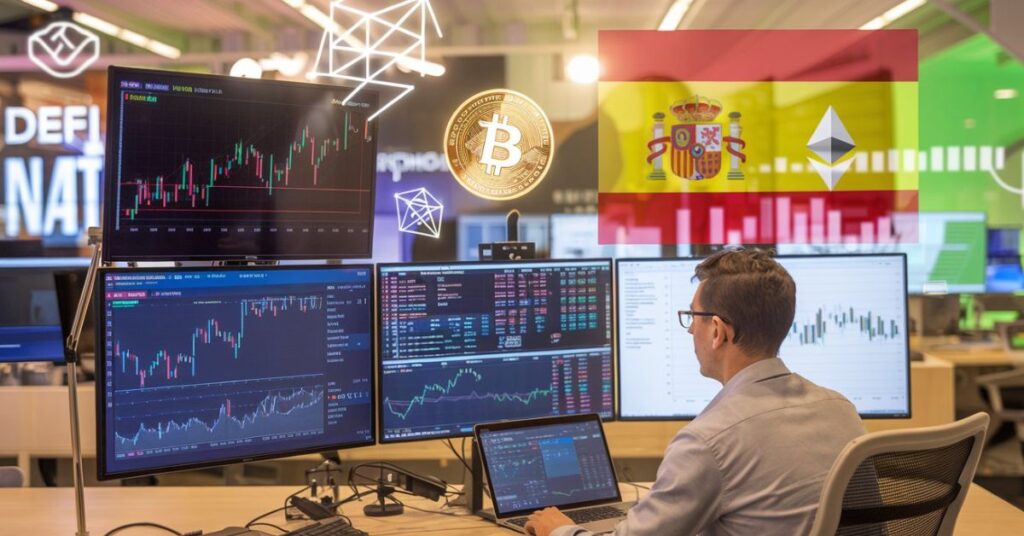Learning about the crypto market can be overwhelming for a beginner. With thousands of coins, where do you even start? Before making any decisions, one core concept—market capitalization—must be understood.
Prime XBT is a trusted crypto trading platform with advanced tools and educational resources. Whether you’re just starting or already trading, Prime XBT helps you make informed choices. Knowing how market cap works can significantly improve your trading decisions there—or anywhere. So, join PrimeXBT today! Use promo code PRIMEOTT to receive a +7% bonus on your deposit.
In this guide, we’ll break down the crypto market cap and why it matters. You’ll learn how it’s calculated and how to use it to compare coins. If you’re serious about crypto, understanding the market cap is non-negotiable. Keep reading to learn more.
What is Crypto Market Cap?

Crypto market cap, short for cryptocurrency market capitalization, is one of the most critical metrics in crypto investing. It gives you a quick snapshot of a coin’s overall value in the market. Think of it as a way to measure how “big” or significant a cryptocurrency is compared to others.
The formula is simple:
Market Cap = Current Price of a Coin × Circulating Supply
For example, if a coin is worth $100 and has 1 million coins in circulation, the market cap is $100 million.
Market cap helps investors understand a coin’s relative size without being misled by its individual price. If a coin priced at $2 has many more coins in circulation, it might have a larger market cap than one priced at $50. This makes market cap a better tool for comparing the true value of different cryptocurrencies.
Types of Market Capitalization in Crypto
Not all cryptocurrencies are created equal. One of the easiest ways to categorize them is by their market cap. Understanding these categories can help you build a balanced portfolio and manage risk more effectively.
Large-Cap Cryptocurrencies
Large-cap cryptos typically have a market cap of over $10 billion. These are the heavyweights of the crypto world, like Bitcoin (BTC) and Ethereum (ETH). Due to their size, liquidity, and strong market presence, they are often viewed as safer investments. However, their growth potential may be slower compared to smaller coins.
Mid-Cap Cryptocurrencies
Mid-cap cryptos have a market cap between $1 billion and $10 billion. Examples include Polygon (MATIC) or Chainlink (LINK). They offer more room for growth than large caps but come with slightly higher risk. These are often newer projects gaining traction in the space.
Small-Cap Cryptocurrencies
Small-cap cryptos have market caps under $1 billion. These coins can see explosive growth but carry high volatility and risk. They’re more susceptible to market manipulation and price swings. That said, some early investors in small-caps have seen massive returns—if they picked the right ones.
Categorizing coins by market cap helps you assess their potential for growth, stability, and risk. It’s a valuable tool for both new and seasoned investors.
Why Market Cap Matters in Cryptocurrency

Regarding crypto investing, market cap does more than rank coins—it helps you evaluate their overall value and risk. A coin’s price alone can be misleading, but the market cap tells a fuller story.
Market cap gives you an idea of a project’s size and influence in the crypto ecosystem. A higher market cap usually means the coin is more established, with a more extensive user base and greater liquidity. That can make trading easier and reduce volatility.
Market cap is also a useful tool for assessing investment risk. Large-cap coins tend to be more stable, while small-cap ones can be highly volatile. This makes market cap helpful in diversifying your portfolio and setting expectations around risk and return.
Lastly, the market cap lets you compare coins more fairly. A low-priced coin doesn’t mean it’s undervalued—its supply might be huge. The market cap cuts through the noise and helps you focus on real value.
Limitations of Crypto Market Cap
While market cap is a valuable metric, it’s far from perfect. Relying solely on it can lead to misunderstandings and risky decisions. Here’s why it’s essential to look beyond just the numbers.
1. Market Cap Doesn’t Reflect Project Fundamentals
Market cap doesn’t consider the underlying fundamentals of a cryptocurrency project. A high market cap doesn’t guarantee real-world utility or strong development. A coin can be driven by hype rather than actual value. Without understanding the project behind the coin, relying solely on the market cap can be misleading.
For example, a coin could be inflated by social media influence or speculative trading, not its technology. Always dig deeper into the project’s goals, team, and use case.
2. Inaccurate Circulating Supply Can Distort Market Cap
The accuracy of a coin’s circulating supply directly affects its market cap. The market cap can be misleading if supply numbers are inaccurate or manipulated. For example, some projects might include tokens that aren’t circulating yet, inflating the market cap. Always check for transparency in circulating supply data.
Many projects don’t update their supply numbers regularly, which can result in inflated market caps. This is common in newer or smaller cryptocurrencies.
3. Market Cap Doesn’t Account for Liquidity
Market cap doesn’t account for a cryptocurrency’s liquidity or daily trading volume. A coin might have a high market cap but a low trading volume, making it less liquid. Low liquidity means buying or selling large quantities could cause significant price changes. This makes the coin harder to trade without affecting its value.
Investors should always consider liquidity alongside market cap to assess potential risks. A low-volume coin can be more volatile and more complex to trade effectively.
4. Market Cap Can Be Easily Manipulated
The cryptocurrency market is still developing, and it’s vulnerable to manipulation. Projects with low liquidity or limited market interest can be easily pumped and dumped. Coordinated efforts by investors can drastically increase a coin’s market cap quickly.
Such manipulation can make market cap numbers misleading, especially for small-cap coins. When evaluating a coin’s true value, it’s important to consider other metrics, like trading volume and community activity.
Crypto Market Cap vs Fully Diluted Market Cap

While the market cap is helpful, it’s also essential to understand the fully diluted market cap (FDMC). These two metrics are related but offer different perspectives on a coin’s potential value.
What is a Fully Diluted Market Cap?
A fully diluted market cap refers to the total potential value of a cryptocurrency if all of its tokens are in circulation. It’s calculated using the max supply instead of the circulating supply. Formula:
FDMC = Max Supply × Current Price
For example, if a cryptocurrency has a max supply of 10 million coins and a current price of $50, the fully diluted market cap would be $500 million.
Why Fully Diluted Market Cap Matters
The fully diluted market cap offers insight into what the coin could be worth if all tokens are eventually mined or released. This metric is crucial for coins with fixed supply caps like Bitcoin or scheduled token unlocks. It helps investors assess the long-term inflationary effects that may impact the coin’s price.
Market Cap vs FDMC: Which should be used?
While market cap gives a snapshot of a coin’s current value, FDMC provides a sense of its potential long-term market value. For investors, it’s crucial to consider both when evaluating a coin’s long-term growth.
For instance, a coin with a lower current market cap but a significantly higher FDMC could face dilution in the future, affecting its price.
Market Cap vs Trading Volume
While market cap is a key metric, trading volume is just as important in evaluating a cryptocurrency. The market cap shows the coin’s total value, but trading volume indicates how actively it is being traded.
What is Trading Volume?
Trading volume refers to the total number of cryptocurrency coins bought or sold within a specific time frame—usually 24 hours. It shows how much trading activity is taking place for that coin. High trading volume suggests much interest and liquidity, while low volume means less activity and more volatility.
How Trading Volume Complements Market Cap
Market cap alone doesn’t give a complete picture of a coin’s market strength. A high market cap with low trading volume could signal that the coin is more stable but lacks investor interest. Conversely, a lower market cap with high trading volume could indicate more volatile price swings but growth potential.
Example of Volume Impact
For instance, Coin A has a market cap of $10 billion and a trading volume of $5 million. Coin B has a market cap of $2 billion but a trading volume of $500 million. Although Coin A has a larger market cap, Coin B is more actively traded and could be a better candidate for short-term trading.
Why Both Matter
When analyzing a cryptocurrency, looking at both market cap and trading volume is essential. A high market cap and trading volume combination suggest a more stable investment with solid liquidity. On the other hand, a high market cap with low volume may signal a coin that’s harder to trade or has limited interest.
Tools to Check Crypto Market Cap
To make informed decisions, it’s essential to use reliable tools to check the crypto market cap. Several platforms provide accurate, up-to-date information, helping you assess the value of different cryptocurrencies effectively.
1. Prime XBT

Prime XBT is a trusted and well-known trading platform offering a variety of tools for cryptocurrency traders. Similar to Binance, Prime XBT provides real-time insights into market cap, trading volume, and price movements.
The platform’s interface allows you to easily track and monitor cryptocurrencies’ performance. Whether you’re a beginner or an experienced trader, Prime XBT offers essential data and a wide range of tools to enhance your crypto trading experience.
2. CoinMarketCap
CoinMarketCap is one of the most popular and widely used platforms for tracking cryptocurrency market data. It provides real-time market cap, price, volume, supply, and more information for thousands of cryptocurrencies. The website offers easy-to-read charts and tools to help you analyze the market.
3. CoinGecko
CoinGecko is another excellent tool for tracking market cap and other vital metrics like trading volume, liquidity, and historical price data. It’s a user-friendly platform that offers additional insights into market trends, developer activity, and community engagement.
4. CryptoCompare
CryptoCompare provides detailed information about market cap, price, volume, and comprehensive data on exchanges and crypto portfolios. It also features live market data, price alerts, and advanced charts to assist with your research.
5. Messari
Messari is a tool designed for advanced users and professionals who want in-depth market analysis. It includes market cap data, insights into the crypto industry’s macro trends, detailed project profiles, and on-chain metrics.
6. Nomics
Nomics is a platform that focuses on transparency in the crypto space. It provides real-time data on market cap, price, volume, supply, and information about exchanges and assets. Nomics uses a unique “Clean Market Cap” model to ensure accurate market cap calculations.
How to Use Market Cap for Crypto Investing
Crypto investors must understand the market cap to make smart investments. It helps you gauge a coin’s relative size in the market and gives you insights into its potential growth and stability. Here’s how to effectively use a market cap when evaluating cryptocurrencies for investment.
1. Identifying Investment Opportunities
Market cap helps you understand the overall scale of a cryptocurrency. Coins with a large market cap, such as Bitcoin or Ethereum, are typically more stable and less prone to wild price swings. These are often considered safer, long-term investments.
On the other hand, coins with a smaller market cap are usually riskier but may present more significant growth potential. Investors looking for high returns may focus on these coins, but they have higher volatility and risk.
2. Assessing Market Trends
By monitoring market cap over time, you can assess trends in the crypto market. If a coin’s market cap steadily increases, it could indicate growing investor interest and positive price action. However, a sudden drop in market cap could signal potential issues, such as regulatory challenges or loss of investor confidence. Tracking these changes can help you make informed decisions about holding or selling a particular asset.
3. Diversifying Your Portfolio
The market cap allows investors to diversify their portfolios effectively. To reduce risk, it’s wise to balance your holdings between large-cap, mid-cap, and small-cap coins.
- Large-cap coins offer stability but have limited growth potential.
- Mid-cap coins strike a balance, providing potential for growth with moderate risk.
- Small-cap coins carry the most risk but also offer the highest potential returns.
Diversifying this way helps protect your portfolio from significant losses while positioning it for long-term gains.
4. Evaluating the Potential for Future Growth
Market cap is not a static number. As new coins enter the market or current coins gain or lose value, their market caps change. A rising market cap can indicate that a project is growing and gaining adoption, making it a good candidate for future investment. However, the market cap alone shouldn’t be the only factor in your decision. Consider other factors like technology, team, use case, and overall market sentiment.
5. Comparing with Similar Cryptocurrencies
The market cap allows you to compare cryptocurrencies within the same sector or niche. For example, suppose you’re interested in DeFi (Decentralized Finance). In that case, you can compare the market caps of various DeFi coins to see which has the most growth potential relative to others in the space. Such comparisons can help you identify which projects are leading in adoption and innovation.
Conclusion
Making informed investment decisions requires understanding the crypto market cap. It provides insight into a cryptocurrency’s size, stability, and growth potential, helping you manage risks effectively. Remember, the market cap is just one factor when choosing investments.
For better trading and risk management, explore On Tilt Trading Store, where you’ll find various tools designed to help you confidently navigate the crypto market. Whether a beginner or an experienced trader, these resources can help you make brighter, more informed decisions.



